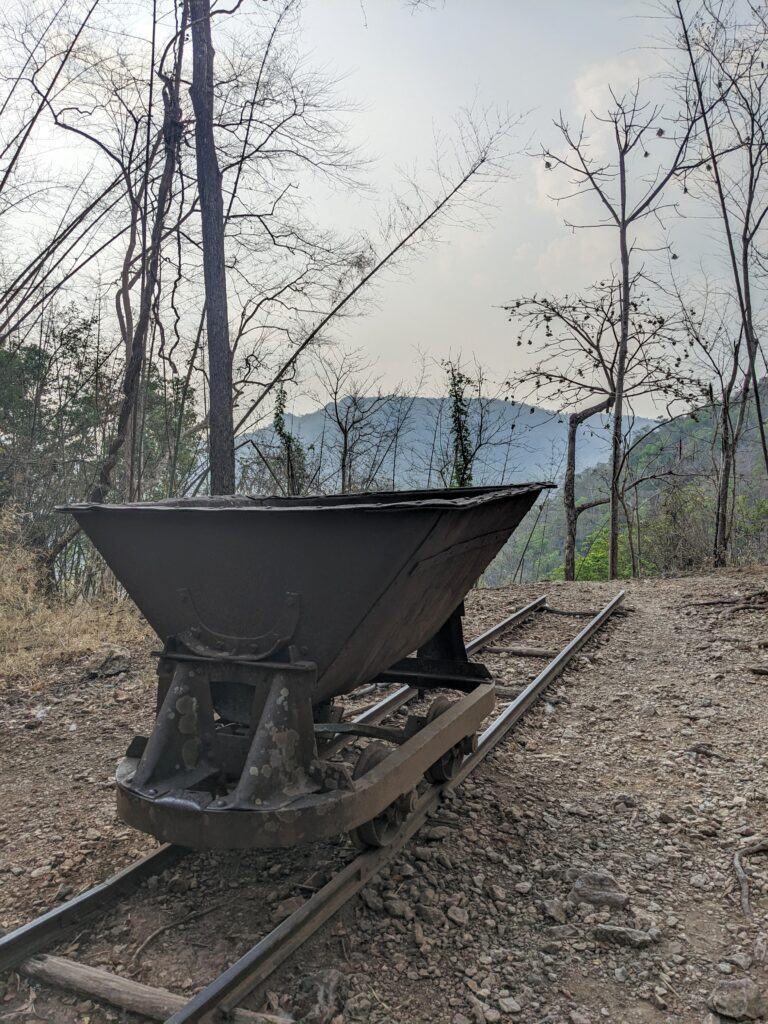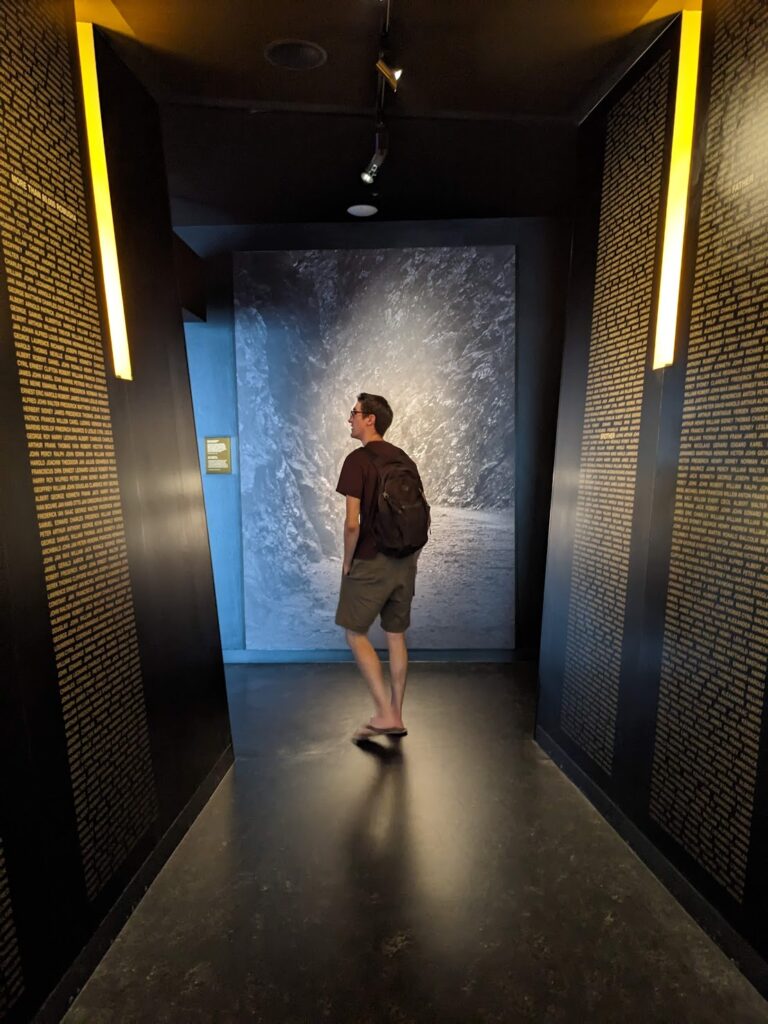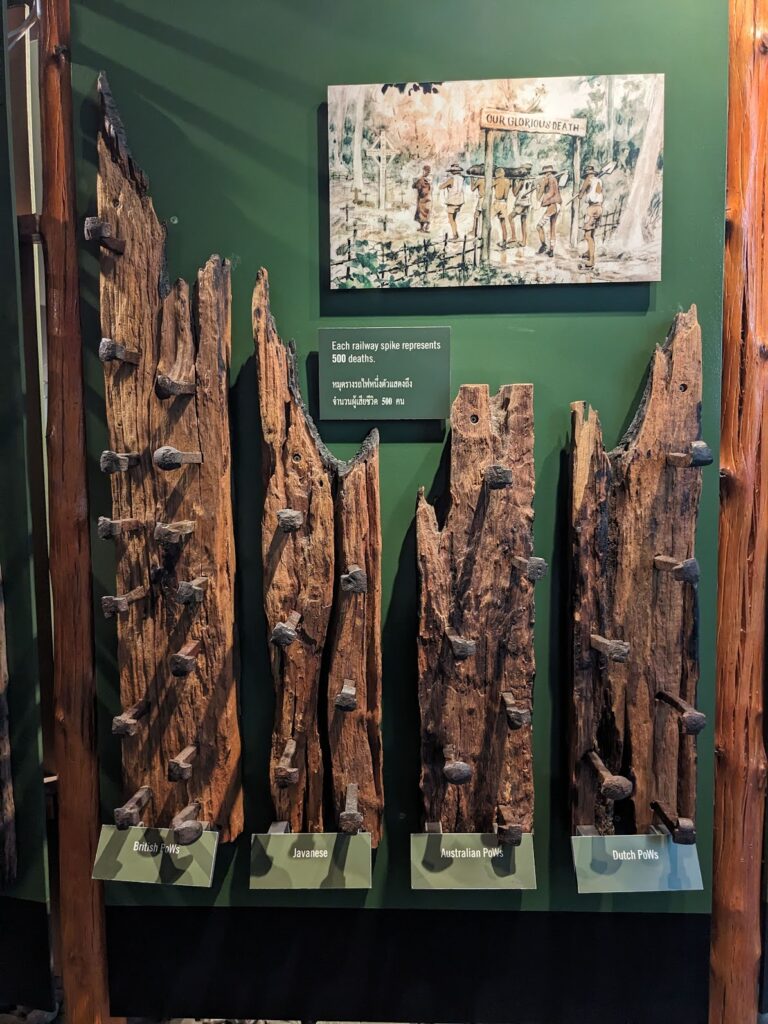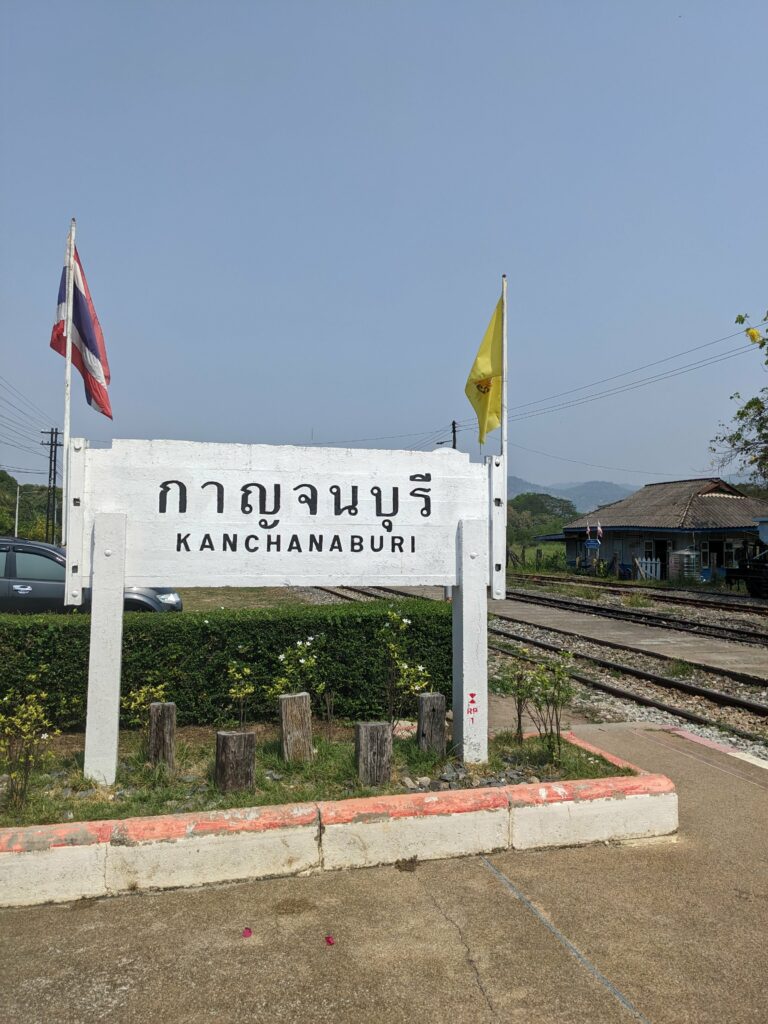Today, Kanchanaburi sits close to the end of the train line west of Bangkok, but during the Second World War it briefly connected Thailand to Burma (now Myanmar). So poor were the workers’ conditions that tragically more than 100,000 prisoners of war and civilians lost their lives during its construction, and thus this line became known as the Death Railway.
We took an early morning taxi across Bangkok to the old Thonburi station to meet up with the 07:50 train to Kanchanaburi. Travelling by rail was definitely slower than road, but it would have felt wrong to take the bus on a route with such historical significance.

Shortly after arriving in Kanchanaburi, we set off on an afternoon excursion to Hellfire Pass – a cutting through the rock necessary to avoid steep inclines on the railway. To get here, we first headed to the bus station, only to find out the (supposedly hourly) bus wasn’t for an hour and ten minutes, and as we sat there waiting in the baking heat, we discussed our hopes that this wasn’t going to turn into another disastrously-rushed trip like in Alerverdi, Armenia. Progress was slow when we finally began our 87 km journey towards Hellfire Pass, and I could see that we were getting further and further behind schedule. As we chugged along, Sara pointed at a few guesthouses and remarked that at least we’d have somewhere to stay the night if we missed the last bus home, and I could tell she was only half joking.

Arriving at Hellfire Pass, we were met straight off the bus by a chap who worked for the Office of Australian War Graves. As kind and helpful as he was, he couldn’t stop the museum from closing in fifteen minutes time, so he suggested (in the nicest possible way) that we get a move on. On top of that, he recommended that we were back at the bus stop in good time if we didn’t want to miss the last bus back to Kanchanaburi (which he explained was highly unpredictable and could arrive any time between in one and three hours’ time). To be on the safe side, this gave us a whole 45 minutes to explore the rest of the site!

At the museum, we learned the reason why it was nicknamed “Hellfire Pass”. One of the prisoners of war likened the view from the top of the cutting at night to something from Dante’s Inferno – with fires burning at intervals of 20 feet and shadows of forced labour moving through the darkness. Beyond the museum, we continued down some wooden steps onto the pass itself. The views from the pass across the mountains were stunning, which made it almost impossible to imagine how miserable it must have been to work on the railway. It was only once we continued along the pass and through the cutting that the scale of the operation became clear, having just learned about the basic tools that were available to create such a path through the mountain.


Fortunately for us (and unfortunately for the nearby guesthouses), we made it back to the bus stop in time for the last bus back to Kanchanaburi. At this point we were feeling like intrepid explorers who were very far from home, before meeting a chap at the bus stop from Weymouth, Dorset. Small world, as they say!
The following day, we (more sensibly) spent the morning in Kanchanaburi, visiting its famous bridge and a couple of museums. The town’s rail bridge spans a nearby river, which was made famous by the book and subsequent film The Bridge on the River Kwai. However, there’s only one catch – this was the bridge, but this wasn’t the River Kwai. But after the success of said movie, tourists began the turn up in town looking for the River Kwai, so the Thai authorities ingeniously renamed the river in an effort to meet visitors’ expectations.


Sadly, the bridge’s tragic history didn’t end with its construction. In 1945, when news came that a bombing raid on the bridge was imminent, the occupying Japanese forces sent hundreds of prisoners of war out to line the bridge, ostensibly to prevent the raid. The tactic didn’t work, and the allied bomb destroyed the middle section of the bridge, and many more prisoners of war met their end here.

We returned to our guesthouse to find a concerned member of staff who called out to us even as we were still in the road: “Oliver, why you miss breakfast?!” I mean, she had a point – we’d paid for breakfast when we booked the room but since completely forgotten. Still, they were very kind not just to notice, but also to keep the breakfast out for long enough for us to enjoy a snack after our morning outing.

Our final stop in Kanchanaburi was the excellent Death Railway Museum, which really helped put everything we’d seen into context. We learned that while around 12,000 Allied prisoners lost their lives during the railway’s construction, a further 90,000 Asian labourers were also killed, most of whom were not recorded and left no surviving accounts. The working conditions for all workers were awful, but we learned about some of the factors that affected the survival rates in different camps, such as proximity to a clean water source, distance between the camp and work site, and the existence of effective administration on both the Japanese and prisoner of war sides. The museum sought to explain the reasons behind the brutal treatment of the railway workers, which worsened over time as the the Japanese chain of command put more and more pressure on those supervising the construction of the railway. It was no surprise that progress was slower than the schedule set by those in command, since the original inspection party of Japanese engineers had told their commanders that the topography was not suitable for a railway, but had been ordered to begin work regardless.

The museum also described how much of this information was learned via secret diaries and photographs that were buried with the dead, which were found later when their bodies were exhumed after the war. Most crushing of all, we learned how some prisoners of war felt ambivalent when the war finally came to an end, and struggled to return to previous relationships and careers as a result of their mental or physical condition.
British forces dismantled part of the railway connecting the two countries following the war, returning equipment and supplies to the countries from where they had originated. The remaining assets were sold to Thailand, with the warning that the railway track was incomplete. However, the Thai Minister of Communications somehow missed this memo, and his inspection party’s train hurtled into a ravine where a bridge had once stood. The minister died soon after the incident, and thus ended the use of the Death Railway with one final tragedy.
After just a single night in Kanchanaburi, we continued our journey south towards the seaside town of Prachuap Khiri Khan.
